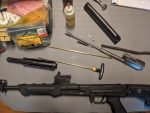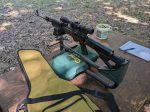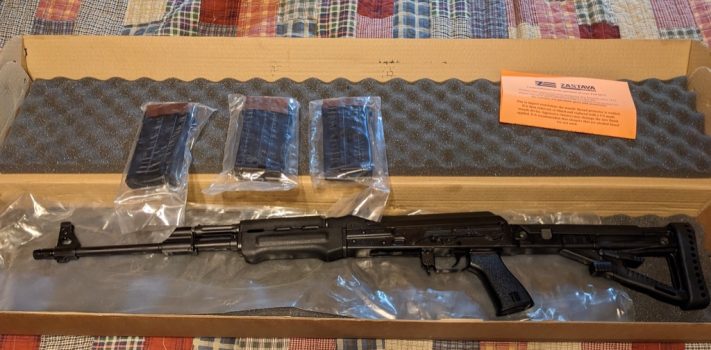The Bottom Line, Up Front
Capable of surprising accuracy when using the right ammo, the Zastava PAP M77PS in .308 Win offers an AK pattern rifle chambered in .308 Winchester. It is durable, reliable, and comes with a 20 round steel magazine. If you are looking for a semi-automatic rifle chambered in a full-powered rifle cartridge with a magazine capacity of more than 10 rounds, this rifle may be a good choice.
The Back Story
I must admit to a certain fondness for AK-pattern rifles. They have durability and reliability that appeals to me. It is true that in some ways they resemble tractors more than limousines. Some might see them as ungainly or even ugly. But under field conditions, they are likely to function a higher percentage of the time than many more-refined-looking firearms.
Although I like rifles which were originally designed east of the Iron Curtain, I like those rifles best when they are chambered for cartridges that were originally designed west of the Iron Curtain. Simply put, 5.56x45mm and 7.62x51mm are ballistically superior to 7.62x39mm and 7.62x54R. They both are also more readily available on the U.S. market.
So when Zastava recently offered me the chance to try out their PAP M77PS in .308 Winchester, I jumped at the opportunity. Twelve days later, I picked up the rifle at my FFL.
First Impressions
 The product box contained the rifle in a plastic bag, three steel 20-round magazines in plastic bags, the manual, a note warning against the use of alcohol-based cleaners (which may damage the finish), and a cleaning rod. The magazines are US-made to ensure 922r compliance. I have previously ranted against Title 18 of the US Code, Chapter 44, Section 922, Subsection r. I shared that rant in my review of the Zastava PAP M90 PS. If the Supreme Court does a good job of repealing gun laws that are not in the historical tradition of firearm regulation, they will get rid of 922r. It is silly to have a law that can turn an unsuspecting gun owner into a felon if he accidentally inserts the wrong magazine into his firearm.
The product box contained the rifle in a plastic bag, three steel 20-round magazines in plastic bags, the manual, a note warning against the use of alcohol-based cleaners (which may damage the finish), and a cleaning rod. The magazines are US-made to ensure 922r compliance. I have previously ranted against Title 18 of the US Code, Chapter 44, Section 922, Subsection r. I shared that rant in my review of the Zastava PAP M90 PS. If the Supreme Court does a good job of repealing gun laws that are not in the historical tradition of firearm regulation, they will get rid of 922r. It is silly to have a law that can turn an unsuspecting gun owner into a felon if he accidentally inserts the wrong magazine into his firearm.
The sturdy steel magazines arrived somewhat oily and had PW32 Protek Wrap over their feed lips. The letters “USA” are prominently stamped on the follower, magazine body, and baseplate to avoid any confusion in relation to the 922r compliance issues mentioned above.
The rifle is fairly heavy at 8 pounds, unloaded. The American-made Archangel stock (another concession to 922r compliance) can be adjusted for length of pull, and includes an adjustable cheek rest and a somewhat hard recoil pad. The American-made TD Inc. pistol grip with an integrated storage compartment is another concession to 922r compliance.
The gas tube can be adjusted for three settings: standard use; light loads/cold weather; and hot loads/hot weather. This feature, as well as the bolt catch slot on the safety lever, were familiar to me from the M90 review referenced above.
The typical AK sights are a little challenging for aging eyes to acquire, and require a specialized AK sight tool to adjust.
The rifle is made in Serbia.
The machining where the gas piston connects to the bolt assembly shows some tool marks. I suspect that the piston was changed in another concession to 922r compliance. Otherwise, the rifle displays unusually good fit and finish for an AK pattern rifle. In fact, it exhibited the best fit and finish that I have ever seen on an AK. This is admittedly a somewhat low bar, since Eastern Bloc manufacturing focused more on functionality than appearance, and the resulting products could be somewhat rough and ready as a result. It is nice to see that Zastava currently manifests significantly better quality control than was typical of iron-curtain-era, eastern-block manufacturing.
Magazine insertion and removal is fairly typical for an AK pattern rifle, although it helps not to even touch the magazine until the release lever is fully depressed.
Like most AK pattern rifles that I have used, the cleaning rod is shorter than the barrel. I don’t think I would want to use a steel cleaning rod in my barrel anyway, but I am curious about how one can clean the barrel with such a short rod. If any SurvivalBlog readers have any insight into this matter, I would welcome enlightenment at ThomasKChristianson at gmail dot com.
The Manual
I read the entire manual, with the exception of the excruciatingly boring state-by-state warnings that I have read many times previously. I recommend that Zastava move these warnings to the end of the manual to avoid unintentionally inducing narcolepsy in innocent readers.
The rest of the manual was easily understandable, although it sounded a little like it was originally written in a language other than English. Phrases like “Do not use your firearm before you get familiar with using this firearm”, or “Always keep and carry your weapon empty and blocked, except when you intend to shoot, so that it cannot be fired when you do not mean it” were common.
The manual recommends cleaning the rifle before first use. It also recommends allowing the barrel to cool after 80 rounds of steady fire. This will prevent rounds in the chamber from spontaneously cooking off due to high temperatures.
The manual also recommends that a qualified armorer zero the rifle. This seems a bit excessive, since an AK sight adjustment tool is not especially difficult to use.
The maximum range is considered to be 1,000 meters. As is common with most AK pattern rifles, adjustments for elevation for various ranges are engraved on the rear sight.
The directions for field stripping are exceptionally clear.
The manual recommends the use of dry lubricant rather than oil if the rifle is to be used in below-freezing conditions. This advice reflects experience gained under bitter winter conditions in Eastern Europe. I remember my father-in-law, who served in the 82nd Airborne during World War II, recounting an incident during the Battle of the Bulge. His squad surrounded a German unit, but none of their rifles would fire because they were all frozen. Ultimately, their Lieutenant’s handgun was the only weapon capable of firing. Fortunately, one shot was sufficient to motivate the surrender of the German unit, which was awakened from a sound sleep by the report. I have had my shotgun freeze a time or two while goose hunting, but that was due to freezing precipitation on the outside rather than to frozen lubricant on the inside. By the way, TW25B gun grease is rated for use down to -90 degrees Fahrenheit. I would recommend it rather than dry lube for sub-freezing conditions.
The manual also includes a decent exploded diagram and parts list.
I was surprised to find the table of contents at the end of the manual.
Range Session #1
It was a beautiful, sunny June morning. The temperature was 73 degrees Fahrenheit, heading for a forecast high of 87 degrees Fahrenheit. There was no wind. The birds were singing in the trees. It was a glorious day.
Well, it was a glorious day except for the mosquitoes. There were enough of them around that I pulled on a bug jacket. With the protection provided by the bug jacket, the mosquitoes were not a significant problem.
I put targets on a stand in front of the back stop, and set up a table 25 yards away. I put a lead sled on the table, put the rifle on the sled, and loaded a single round of Winchester 7.62x51mm 149 grain FMJ ammo (standard M80 ball ammo). That first shot hit 2.5 inches high and 1 inch to the right of my point of aim. The trigger was the best that I have ever used on an AK platform. There was some creep, of course, but the break was crisp and unexpected.
I adjusted the sights with an AK sight adjustment tool and then fired another round at the target. It was close enough to the point of aim that I followed it with 2 more rounds to produce a 3 shot group. The group was .95 inches in size. I figured that wasn’t too bad for aging eyes firing an AK over iron sights, so I took the rifle in the house for a cleaning.
Cleaning
 Cleaning was pretty typical for an AK, with a couple of minor exceptions. One was the spring lock button on the left side of the receiver. I could not remove the dust cover until I reread the manual and depressed the spring lock button. I then removed the dust cover, recoil spring assembly, bolt carrier and bolt. The gas tube locking lever was quite difficult to rotate, as is common, and required the use of the pliers on my Leatherman Skeletool. I then removed the gas tube assembly and upper hand guard.
Cleaning was pretty typical for an AK, with a couple of minor exceptions. One was the spring lock button on the left side of the receiver. I could not remove the dust cover until I reread the manual and depressed the spring lock button. I then removed the dust cover, recoil spring assembly, bolt carrier and bolt. The gas tube locking lever was quite difficult to rotate, as is common, and required the use of the pliers on my Leatherman Skeletool. I then removed the gas tube assembly and upper hand guard.
I cleaned the bore and other parts with solvent, then a dry patch, and then CLP, with the exception of the gas tube and gas piston. I cleaned them with a brush and dry patch only, since any lube in the gas tube just gets converted to excess carbon the first time the rifle is fired.
Mounting a Scope
 Every time I mount a scope on an AK pattern rifle, I wonder if it is an exercise in futility. Between the inherent inaccuracy of many AKs, and the many opportunities for the ungainly AK side scope mount to be knocked out of zero, I often feel that mounting the scope is a victory of hope over expectation. AK iron sights, on the other hand, are poor enough that almost anything may be an improvement. I decided that the M77 deserved a fair chance.
Every time I mount a scope on an AK pattern rifle, I wonder if it is an exercise in futility. Between the inherent inaccuracy of many AKs, and the many opportunities for the ungainly AK side scope mount to be knocked out of zero, I often feel that mounting the scope is a victory of hope over expectation. AK iron sights, on the other hand, are poor enough that almost anything may be an improvement. I decided that the M77 deserved a fair chance.
I attached the scope mount, set the scope loosely in the rings, and attached the rings to the rail. I then made a preliminary eye relief adjustment.
The stock has an adjustable comb, but it was not quite high enough. I duck-taped a couple of layers of cardboard to the adjustable comb to get a better cheek weld.
I then leveled the scope, and tightened the rings evenly.
Range Session #2
 It was a sunny afternoon in late June. The temperature was 77 degrees Fahrenheit, and rising quickly. The humidity was low, and winds were light and variable. The mosquitoes, on the other hand, were quite thick. I needed to wear a bug jacket and gloves to avoid unnecessary distraction and/or exsanguination. It took several shots from 25 yards to zero the scope. Subsequent groups averaged about 1 inch in size. From 25 yards, I could shoot the rifle about equally accurately with iron sights as with the scope.
It was a sunny afternoon in late June. The temperature was 77 degrees Fahrenheit, and rising quickly. The humidity was low, and winds were light and variable. The mosquitoes, on the other hand, were quite thick. I needed to wear a bug jacket and gloves to avoid unnecessary distraction and/or exsanguination. It took several shots from 25 yards to zero the scope. Subsequent groups averaged about 1 inch in size. From 25 yards, I could shoot the rifle about equally accurately with iron sights as with the scope.
Range Session #3
For the third range session, I made my way to the 100 yard indoor range of the local rod and gun club. It was very pleasant to shoot in a climate-controlled environment with no mosquitoes.
I struggled a bit longer than usual to get the scope zeroed. Then I tested it with three different types of ammo.
I received the best results from Federal Varmint & Predator 230 grain JHP. Shots using that ammo grouped at about one inch, which is amazingly good for an AK platform rifle.
The Winchester M80 ammo grouped at a little over 2 inches.
Aguila 7.62x51mm 150 grain FMJ ammo, on the other hand, grouped at about 5 inches. It was amazing what a difference the use of different ammo made.
During this third range session, I fired from sandbags rather than a Lead Sled. I was impressed by how effective the gas system of the M77 was at absorbing recoil.
Conclusions
I found the Zastava PAP M77PS in .308 Winchester to be amazingly accurate for an AK platform when using ammo that it liked. A durable and reliable platform with steel magazines of a generous capacity, there is much to like about the M77. As I said at the beginning of this article, if you are looking for a semi-automatic rifle chambered in a full-powered rifle cartridge with a magazine capacity of more than 10 rounds, this rifle may be a good choice.
Disclaimer
Zastava was kind enough to loan me a sample of their PAP M77PS for testing and evaluation. I tried not to let their kindness interfere with my objectivity in this review, and I believe that I have succeeded. I did not receive any other financial or other inducement to mention any vendor, product, or service in this article.










